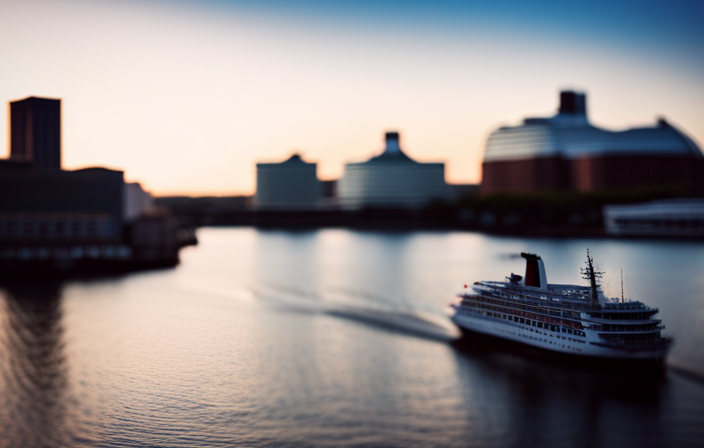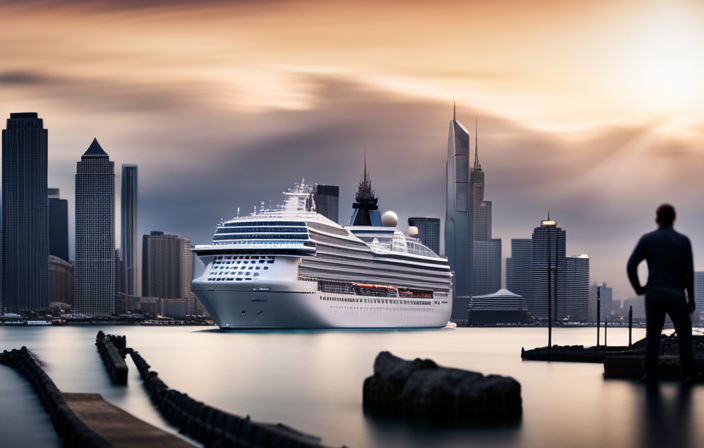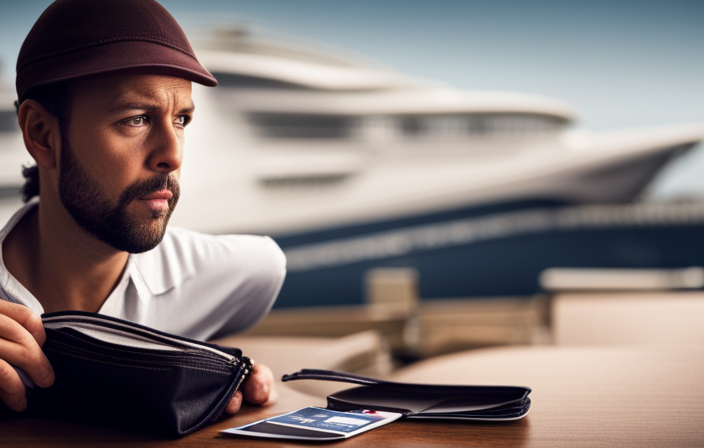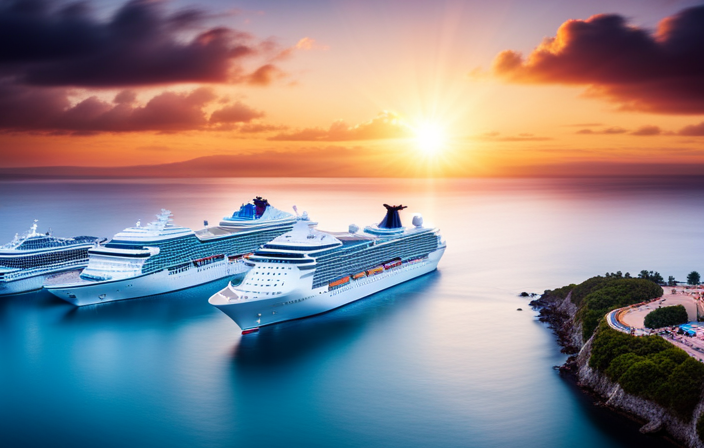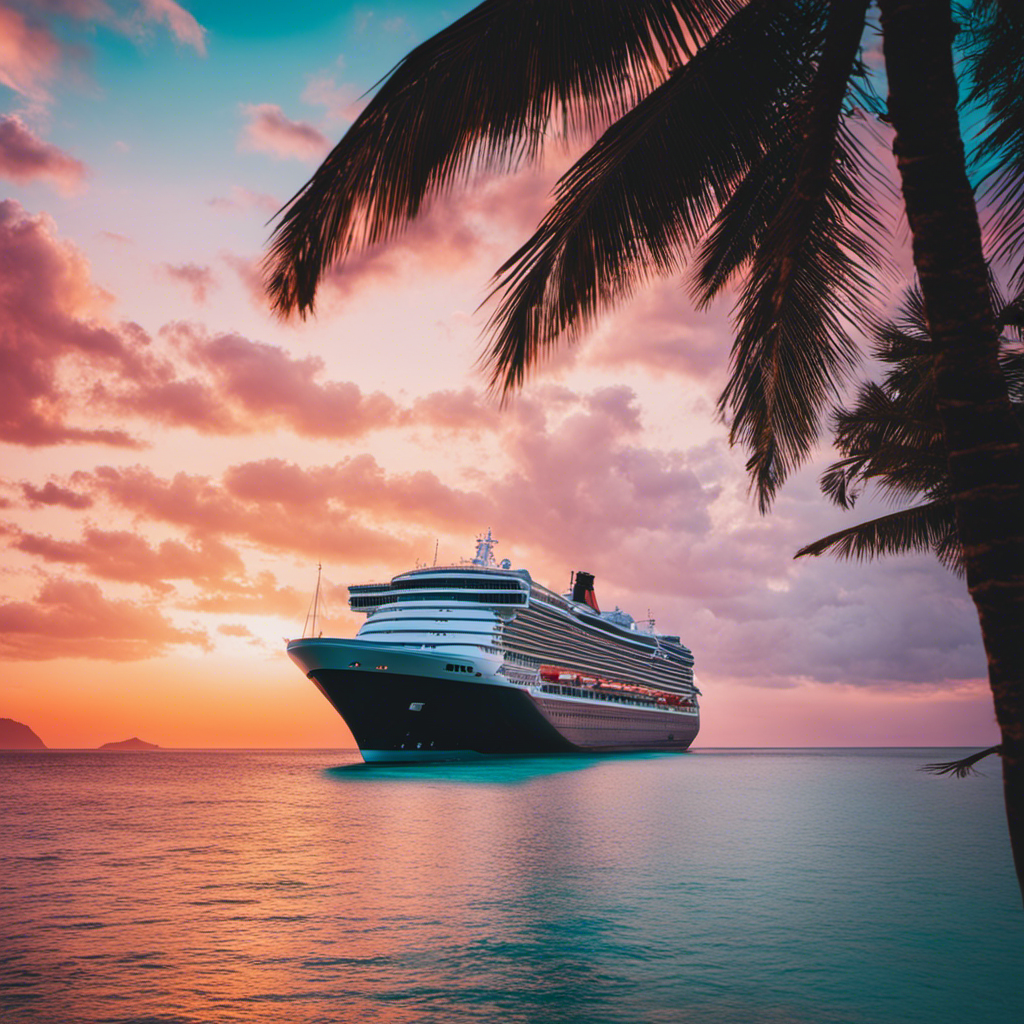Have you ever pondered how a massive cruise ship manages to stay afloat in the vast expanse of the ocean? It’s truly fascinating.
As I delve into the intricate workings of these marvels of engineering and design, prepare to be amazed by the principles of buoyancy and displacement that keep these behemoths from sinking.
With their carefully constructed hulls and state-of-the-art navigation systems, cruise ships are able to navigate through treacherous waters with ease.
And let’s not forget about the powerful engines and propellers that propel these floating cities forward.
But it doesn’t end there – we’ll also explore the role of rudders, water density, and even environmental sustainability in ensuring the safety and longevity of these magnificent vessels.
So join me on this journey as we unravel the secrets behind how a cruise ship defies gravity and stays afloat against all odds.
Key Takeaways
- Lifeboats and life rafts are essential safety measures for safe evacuation in case of emergencies.
- Emergency power systems and evacuation plans are in place to ensure the orderly and efficient evacuation of passengers.
- Regular maintenance and inspections are conducted to ensure the structural integrity of the ship.
- Cruise ships prioritize environmental preservation through the use of renewable energy sources and advanced waste management technologies.
The Principles of Buoyancy and Displacement
Let me explain to you how a cruise ship stays afloat using the principles of buoyancy and displacement. These concepts are fundamental in understanding how the floating phenomenon works.
Buoyancy refers to the upward force exerted on an object immersed in a fluid, like water. This force is equal to the weight of the fluid displaced by the object. In simple terms, if an object weighs less than the amount of water it displaces, it will float.
Cruise ships are designed with large hulls that displace enormous amounts of water, creating enough buoyant force to keep them afloat. The structure and shape of these vessels are carefully crafted to optimize their buoyancy and displacement capabilities.
Now that we understand how buoyancy and displacement work, let’s delve into the design and structure of a cruise ship without any further delay.
The Design and Structure of a Cruise Ship
To understand how a cruise ship stays buoyant, picture this: You’ll be amazed to learn that it takes about 30 Olympic-sized swimming pools worth of steel to construct these floating marvels! The design and structure of a cruise ship are meticulously planned to ensure its stability and safety on the water. From the outside, cruise ships are designed to be aesthetically pleasing, with sleek lines and grandeur. But it’s what’s inside that truly sets them apart. Cruise ships offer an array of interior amenities, including luxurious cabins, restaurants, theaters, and even shopping centers. These amenities are strategically placed throughout the ship to maximize space utilization while maintaining balance and stability. As we delve into the role of the ship’s engines and propellers in the next section, you’ll see how all these components work together seamlessly for an unforgettable cruising experience.
The Role of the Ship’s Engines and Propellers
The ship’s engines and propellers play a crucial role in maintaining the buoyancy and propulsion of the vessel. Without these vital components, the ship would be unable to move through the water efficiently. Here are four key aspects of their function:
-
Power generation: The engines produce mechanical energy that is converted into electricity to power various systems on board.
-
Propeller design: The shape and size of the propellers are carefully engineered to maximize thrust while minimizing drag, allowing for optimal ship propulsion.
-
Fuel efficiency: Modern cruise ships are equipped with advanced propulsion systems that prioritize fuel efficiency by utilizing technologies such as diesel-electric or gas turbine engines.
-
Steering control: The propellers, along with the ship’s rudder and navigation systems, enable precise maneuverability.
Transitioning into the next section about the function of the ship’s rudder and navigation systems, it is important to understand how these components work together to ensure smooth sailing and safe navigation at sea.
The Function of the Ship’s Rudder and Navigation Systems
The ship’s rudder control is responsible for steering the vessel by changing its course. It is typically located at the stern and operated by hydraulic systems controlled by the captain or autopilot.
The ship’s navigation systems, including GPS, provide real-time data on the ship’s position, speed, and heading. By integrating this information with maps and other navigational aids, the crew can accurately determine their location and plan routes accordingly. This advanced technology allows cruise ships to navigate through complex waterways with ease and efficiency.
As we move forward into discussing ‘the importance of water density and saltwater corrosion,’ it becomes evident that these factors play a crucial role in maintaining a cruise ship’s buoyancy and structural integrity without compromising safety.
The Importance of Water Density and Saltwater Corrosion
Water density and saltwater corrosion are critical factors that can impact the buoyancy and structural integrity of a cruise ship, ensuring its safety while navigating through treacherous waters.
-
Water Density:
The density of water plays a crucial role in determining whether an object will float or sink. Ships are designed to displace enough water to create an upward force equal to their weight, allowing them to stay afloat. If the water is less dense, such as in freshwater, the ship may sit higher in the water, affecting stability. -
Saltwater Corrosion:
Saltwater contains corrosive elements that can gradually damage a ship’s hull and other metal components. To counter this, ships undergo regular maintenance and anti-corrosion treatments. Special coatings and sacrificial anodes are used to protect the ship from corrosion.
Considering these factors, it is essential for cruise ships to understand how water density and saltwater corrosion can impact their overall performance.
Transitioning into the subsequent section about the impact of waves and weather conditions, we must also recognize how these external forces further challenge a ship’s stability.
The Impact of Waves and Weather Conditions
When it comes to the impact of waves and weather conditions on a cruise ship, two key points to consider are stabilization systems and anti-roll technology.
These systems play a crucial role in ensuring the stability and comfort of the ship by counteracting the effects of rolling caused by waves.
Additionally, weather monitoring and route planning are essential for avoiding rough seas and adverse weather conditions.
They allow the ship’s crew to chart a course that maximizes passenger safety and comfort.
Stabilization Systems and Anti-roll Technology
Stabilization systems and anti-roll technology are crucial for maintaining the balance and stability of a cruise ship, especially in turbulent waters. These innovative technologies are specifically designed to counteract the natural rolling motion of a ship that is caused by waves and adverse weather conditions.
There are three key features of stabilization technology and roll reduction systems that contribute to the ship’s stability:
-
Active Fin Stabilizers: These large underwater fins can be adjusted to counteract the rolling motion of the ship. By changing their angle and position, they generate forces that oppose the movement, providing stability.
-
Gyroscopic Stabilizers: These devices utilize the principles of gyroscopes and utilize spinning discs to create stabilizing forces that resist roll motions. They effectively minimize side-to-side movement and greatly improve passenger comfort.
-
Anti-roll Tanks: These tanks are filled with water on one side or another to shift the ship’s center of gravity, thereby reducing its tendency to roll. By adjusting the water level in these tanks, ships can effectively counterbalance external forces acting on them.
With the implementation of these advanced stabilization systems, cruise ships can confidently navigate even the most challenging conditions with increased stability and safety. Now, let’s move on to discussing weather monitoring and route planning…
Weather Monitoring and Route Planning
Equipped with advanced technology, cruise ships rely on weather monitoring and route planning to ensure a smooth and enjoyable journey for passengers. Weather forecasting plays a crucial role in determining the safest and most efficient routes to navigate through various weather conditions. Navigational instruments such as radar, GPS, and sonar are used to gather real-time data on wind speed, wave height, and atmospheric pressure. This information is analyzed by onboard meteorologists who work closely with the ship’s captain to make informed decisions about course adjustments or itinerary changes. By constantly monitoring weather patterns, the crew can anticipate storms or other adverse conditions and take proactive measures to avoid them. These meticulous preparations help minimize disruptions and create a comfortable experience for passengers. Transitioning into the subsequent section about safety measures and emergency procedures, it is vital for cruise ships to be well-prepared for any unforeseen circumstances that may arise at sea.
Safety Measures and Emergency Procedures
Lifeboats and life rafts are crucial safety measures on a cruise ship. They are designed to ensure the safe evacuation of passengers in case of an emergency. These small watercrafts are equipped with essential supplies such as food, water, and communication devices to sustain passengers until rescue arrives.
In addition to lifeboats, cruise ships also have emergency power systems in place. These systems provide electricity during a crisis, ensuring that vital equipment remains functional.
Evacuation plans are meticulously crafted and regularly practiced. They are designed to efficiently guide passengers to designated assembly points and facilitate their safe disembarkation from the ship.
Lifeboats and Life Rafts
Hey there! Did you know that when you’re on a cruise ship, there are these cool things called lifeboats and life rafts that are always ready to come to your rescue if needed? These safety devices go through rigorous maintenance procedures to ensure their functionality at all times. Here are three important aspects regarding lifeboats and life rafts:
-
Regular Inspections: Lifeboats undergo regular inspections to check for any signs of damage or malfunction. This includes examining the hull, propulsion system, and emergency equipment.
-
Safety Equipment: Life rafts are equipped with essential safety gear such as survival kits, flares, and signaling devices. These items help passengers stay visible and communicate distress signals effectively.
-
Capacity and Deployment: Lifeboats have a designated capacity based on the number of people they can accommodate safely. They are strategically positioned around the ship for quick deployment during emergencies.
By understanding the meticulous maintenance of lifeboats and the safety procedures associated with life rafts, passengers can feel confident in their ability to handle emergencies at sea.
Speaking of emergencies, let’s now delve into the fascinating world of emergency power systems and evacuation plans.
Emergency Power Systems and Evacuation Plans
When you’re on a cruise, it’s important to understand the intricacies of emergency power systems and evacuation plans, just like navigating through a maze. In case of an emergency, maintaining visibility is crucial for safe evacuation. That’s where emergency lighting comes into play.
These lights are strategically placed throughout the ship and are powered by backup generators to ensure they remain operational even during power outages.
Additionally, passenger muster drills are conducted at the beginning of each cruise to familiarize guests with evacuation procedures. During these drills, passengers are instructed on how to properly wear life jackets and locate their assigned lifeboats or life rafts. This helps ensure an orderly and efficient evacuation process in case of an emergency.
Transitioning into the subsequent section about maintenance and inspections for ship integrity, it is imperative that cruise ships undergo regular checks and assessments to guarantee their safety and functionality at all times.
Maintenance and Inspections for Ship Integrity
Regular maintenance and inspections are crucial for ensuring the integrity of a cruise ship and its ability to stay afloat. A comprehensive maintenance schedule is followed to ensure that all components of the ship are regularly checked and serviced.
This includes routine inspections of the hull, which is a critical part of the ship’s structure that helps it stay buoyant in water. Hull inspections involve examining the entire outer surface for any signs of damage or corrosion, as well as checking for any leaks or cracks that could compromise the ship’s stability. These inspections are typically carried out by trained professionals who use specialized equipment to thoroughly assess the condition of the hull.
By adhering to a strict maintenance schedule and conducting regular hull inspections, cruise ships can maintain their structural integrity and continue to operate safely in various environmental conditions.
Moving on from maintenance, let’s now discuss environmental considerations and sustainability efforts onboard cruise ships.
Environmental Considerations and Sustainability Efforts
Implementing sustainable practices and prioritizing environmental considerations, cruise ships strive to become floating eco-friendly havens, where every action taken on board contributes to the preservation of our planet. To achieve this, cruise ships have implemented various initiatives in sustainable energy and waste management.
In terms of sustainable energy, cruise ships are increasingly utilizing renewable sources such as solar and wind power. Installing solar panels on the ship’s deck and using wind turbines help generate electricity while minimizing reliance on fossil fuels. Additionally, advanced propulsion systems that use cleaner fuels like liquefied natural gas (LNG) are being adopted to reduce emissions.
Waste management is another crucial aspect of sustainability efforts. Cruise ships employ advanced technologies for waste treatment and recycling onboard. This includes wastewater treatment plants that ensure proper processing before discharge into the sea, as well as recycling facilities for plastics, glass, paper, and other materials.
Looking ahead, future innovations and advancements in cruise ship technology will further enhance these sustainability measures. From improved energy-efficient designs to alternative fuel options, the industry continues to strive towards a greener future for cruising.
Future Innovations and Advancements in Cruise Ship Technology
You’ll be amazed by the future innovations and advancements in cruise ship technology, transforming your onboard experience into a greener and more sustainable journey. Here are four remarkable developments in cruise ship technology that contribute to future sustainability and utilize renewable energy:
-
Advanced propulsion systems: Cruise ships will increasingly adopt cleaner propulsion technologies, such as LNG (liquefied natural gas) or hydrogen fuel cells, reducing emissions of greenhouse gases and air pollutants.
-
Energy-efficient designs: Future cruise ships will prioritize energy efficiency through improved hull designs, advanced insulation materials, and optimized ventilation systems, minimizing energy consumption and waste.
-
Solar power integration: Utilizing solar panels across the ship’s surface will harness the abundant energy from the sun to power various onboard operations, reducing reliance on fossil fuels.
-
Waste-to-energy conversion: Innovative waste management systems will convert organic waste into biofuels or biogas through anaerobic digestion processes, providing a renewable source of energy for the ship.
These advancements represent an industry-wide commitment to environmentally friendly practices and a promising future for sustainable cruising.
Frequently Asked Questions
How much fuel does a cruise ship consume on a typical voyage?
On a typical voyage, a cruise ship consumes an astonishing amount of fuel. Its fuel efficiency depends on various factors, such as the ship’s size, speed, and design. Unfortunately, high fuel consumption has a significant impact on the environment.
What measures are taken to prevent corrosion of the ship’s hull?
To prevent corrosion of the ship’s hull, preventive measures are taken. These include applying protective coatings and paints, regular inspections and maintenance, using sacrificial anodes, and implementing cathodic protection systems to ensure the integrity of the hull.
How are waste and sewage managed on a cruise ship?
On a cruise ship, waste disposal and sewage treatment are crucial for maintaining cleanliness and preventing environmental damage. Waste is collected and treated using specialized systems to ensure proper sanitation and protection of marine ecosystems.
What safety measures are in place to prevent accidents like collisions or capsizing?
Ironically, cruise ship safety measures are designed to prevent accidents like collisions or capsizing. Collision prevention includes radar systems, navigation charts, and strict adherence to international maritime regulations. Capsizing safeguards include stability calculations and advanced ballasting systems.
How often are maintenance inspections conducted on a cruise ship?
Maintenance inspections on a cruise ship are conducted according to a strict maintenance schedule. The inspection frequency ensures that all essential components and systems are thoroughly checked and maintained, minimizing the risk of any potential issues or malfunctions.
Conclusion
In conclusion, it is fascinating to delve into the intricate workings of how a cruise ship stays afloat.
The principles of buoyancy and displacement, combined with the design and structure of the vessel, ensure its stability on the water.
The ship’s engines, propellers, rudder, and navigation systems all play vital roles in maneuvering through the vast ocean.
Additionally, considering factors like water density and corrosion prevention are crucial for maintaining the ship’s integrity.
While safety measures and maintenance procedures are diligently followed, it is ironically amusing to ponder how such massive floating cities coexist with their fragile marine surroundings.
As we continue to strive for environmental sustainability and advancements in cruise ship technology, let us not forget the delicate balance between modern luxury and our responsibility to protect our oceans.


